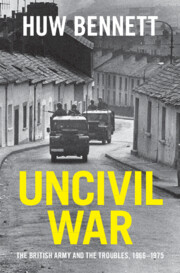Book contents
- Uncivil War
- Cambridge Military Histories
- Uncivil War
- Copyright page
- Dedication
- Contents
- Figures
- Maps
- Tables
- Illustrations
- Abbreviations
- Introduction
- 1 Baggage
- 2 The Army’s Short-Lived Ulster Honeymoon
- 3 Escalation and the Erosion of Impartiality
- 4 Edward Heath’s Bid for Victory
- 5 The Road to Bloody Sunday
- 6 The Most Deadly Year
- 7 Strategy in the Shadow of Loyalist Power
- 8 We Cannot Envisage Peace
- Conclusion
- A Note on Sources
- Acknowledgements
- Notes
- Bibliography
- Index
5 - The Road to Bloody Sunday
Published online by Cambridge University Press: 03 August 2023
- Uncivil War
- Cambridge Military Histories
- Uncivil War
- Copyright page
- Dedication
- Contents
- Figures
- Maps
- Tables
- Illustrations
- Abbreviations
- Introduction
- 1 Baggage
- 2 The Army’s Short-Lived Ulster Honeymoon
- 3 Escalation and the Erosion of Impartiality
- 4 Edward Heath’s Bid for Victory
- 5 The Road to Bloody Sunday
- 6 The Most Deadly Year
- 7 Strategy in the Shadow of Loyalist Power
- 8 We Cannot Envisage Peace
- Conclusion
- A Note on Sources
- Acknowledgements
- Notes
- Bibliography
- Index
Summary
On 23 March 1972 the British cabinet suspended the Northern Ireland parliament, scaled down military operations, and prepared to negotiate with nationalists and republicans. This chapter asks why it took Heath’s government so long to strategically adapt, and what the delay resulted in. A straight causal line is often drawn between internment, Bloody Sunday and direct rule from London being imposed. Bloody Sunday, when the Parachute Regiment shot dead thirteen unarmed protesters during an anti-internment march on 30 January, is considered to have happened in the context of a policy vacuum, or amidst frenetic efforts to secure peace. This chapter argues that the persistence of an offensive strategy intended to defeat the IRA and force nationalists to accept minor constitutional reforms contributed to Bloody Sunday. The direct-rule decision is frequently attributed to the fallout from Bloody Sunday. But the thinking and planning necessary for strategic adaptation had already taken place. The offensive strategy endured for weeks longer because ministers decided to delay direct rule. The massacre propelled large numbers to join the IRA, a recruitment glut essential for the expansion in violence seen during 1972. Those new recruits proved effective because IRA strategy and tactics had already changed before Bloody Sunday.
Keywords
- Type
- Chapter
- Information
- Uncivil WarThe British Army and the Troubles, 1966–1975, pp. 122 - 162Publisher: Cambridge University PressPrint publication year: 2023

